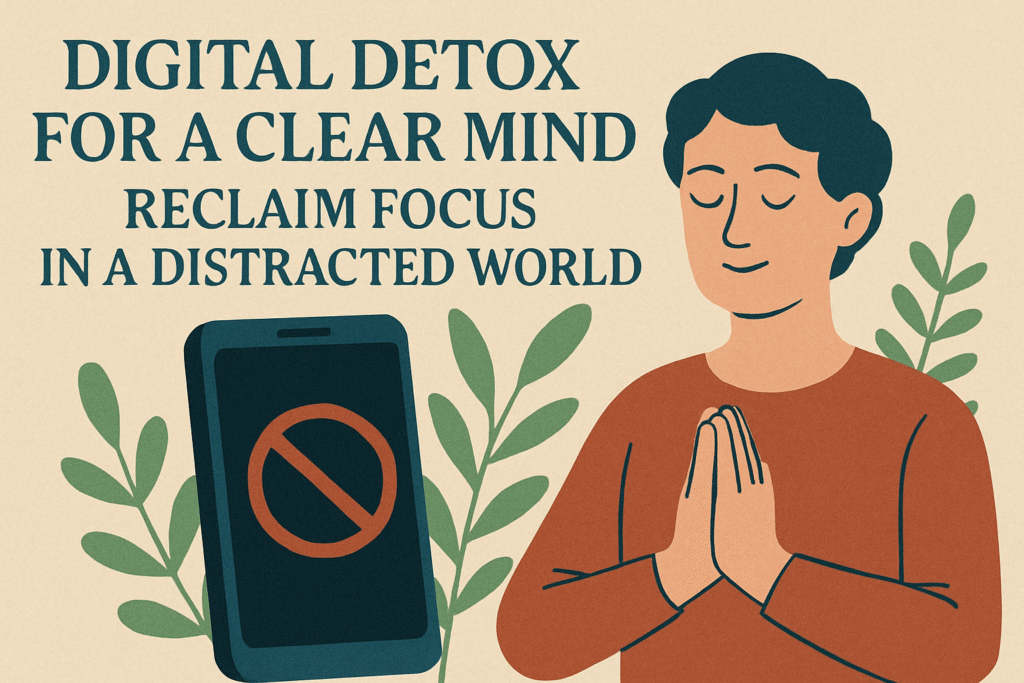In today’s hyper-connected world, constant notifications, social media scrolling, and digital overload have become the norm. While technology keeps us informed and entertained, it often comes at the cost of our mental clarity, productivity, and peace of mind. If you often feel scattered, anxious, or overwhelmed, it might be time to consider a digital detox — a conscious break from screens and digital inputs to reconnect with yourself and the present moment.
What is a Digital Detox?
A digital detox is a period of intentional disengagement from digital devices such as smartphones, computers, tablets, and social media platforms. The goal is not to eliminate technology altogether, but to create healthier boundaries and regain control over your attention and energy.
Why You Need a Digital Detox
- Improves Mental Clarity
Constant digital stimulation can clutter your thoughts and reduce your ability to focus. A detox gives your brain the space it needs to process, reflect, and reset. - Boosts Productivity
Every ping or alert interrupts your concentration. Reducing screen time helps you enter deep work states and get more done in less time. - Reduces Stress and Anxiety
Doomscrolling, comparison traps on social media, and information overload often lead to mental fatigue and emotional stress. - Enhances Sleep Quality
The blue light from screens disrupts melatonin production, making it harder to fall asleep. A detox, especially before bed, supports restful, high-quality sleep.
Signs You Need a Digital Detox
You reach for your phone first thing in the morning.
You feel anxious when your phone isn’t nearby.
You mindlessly scroll for hours and feel drained afterward.
You struggle to focus without checking notifications.
You find it hard to enjoy offline moments.
If you nodded to any of these, a digital detox could be just what you need.
How to Start Your Digital Detox

- Set Clear Goals
Define your “why.”
Are you doing this to improve focus? Reduce anxiety? Sleep better? Clear goals keep you motivated.
- Pick a Realistic Timeframe
Start small. Try:
A 1-hour detox daily
A screen-free morning
A 24-hour weekend challenge
As you get comfortable, you can increase the duration.
- Turn Off Non-Essential Notifications
Disable alerts from social media, email, and shopping apps. This minimizes distractions and helps you control your attention.
- Create Tech-Free Zones
Designate areas like the bedroom, dining table, or your workspace as device-free zones to promote mindfulness.
- Use Tools to Limit Usage
Ironically, tech can help you detox. Try apps like:
Forest – encourages focus by planting virtual trees.
Focus Mode – built-in on Android.
Freedom – blocks distracting websites and apps.
- Replace Screen Time with Offline Activities
Read a physical book
Take a walk in nature
Journal or sketch
Practice meditation or yoga
Have a face-to-face conversation
Tips to Make Your Digital Detox Successful
Tell others: Let friends and family know about your detox so they can support you or join in.
Schedule your check-ins: Instead of constant access, decide fixed times to check emails or messages.
Celebrate small wins: Every moment you reclaim from the digital world is a victory for your mental well-being.
Long-Term Benefits of Regular Digital Detoxes
Sharper focus and creativity
Deeper connections with people
More intentional living
Lower stress levels
Greater self-awareness
Digital detox isn’t about abandoning technology—it’s about using it consciously, not compulsively.
In a world full of distractions, choosing stillness is a powerful act. A digital detox helps you reclaim your attention, reconnect with your inner self, and refocus on what truly matters. Even short breaks can have a profound impact on your clarity and peace of mind.
So, take a deep breath, turn off your phone, and step into the present—you might just find the calm you’ve been missing.
Leave a Reply